The Medulla Nebula (CTB 1) is a large supernova remnant located in the constellation Cassiopeia. The expanding gas shell is associated with the Cannonball Pulsar (PSR J0002+6216), one of the fastest moving pulsars known.
The bubble of gas formed when a massive star reached the end of its life and went out as a luminous supernova around 10,000 years ago. The stellar remnant was nicknamed the Medulla Nebula because it looks like a cross section of the human brain and the lower part of the brainstem (medulla oblongata). The circular bubble is visible both at optical and radio wavelengths.
Supernova remnants are composed of material ejected from the massive progenitor stars and interstellar material swept up by the expanding shock wave. Supernovae expel most or all of the stellar material at exceptionally high velocities that can be as much as 10% of the speed of light. The powerful shock wave that forms as a result heats the plasma to temperatures of millions of kelvins. The shock wave eventually slows down, but it can keep expanding for thousands of years before its velocity falls below the speed of sound. After about 30,000 years, supernova remnants slow down to the speed of the interstellar medium and merge with the surrounding environment.
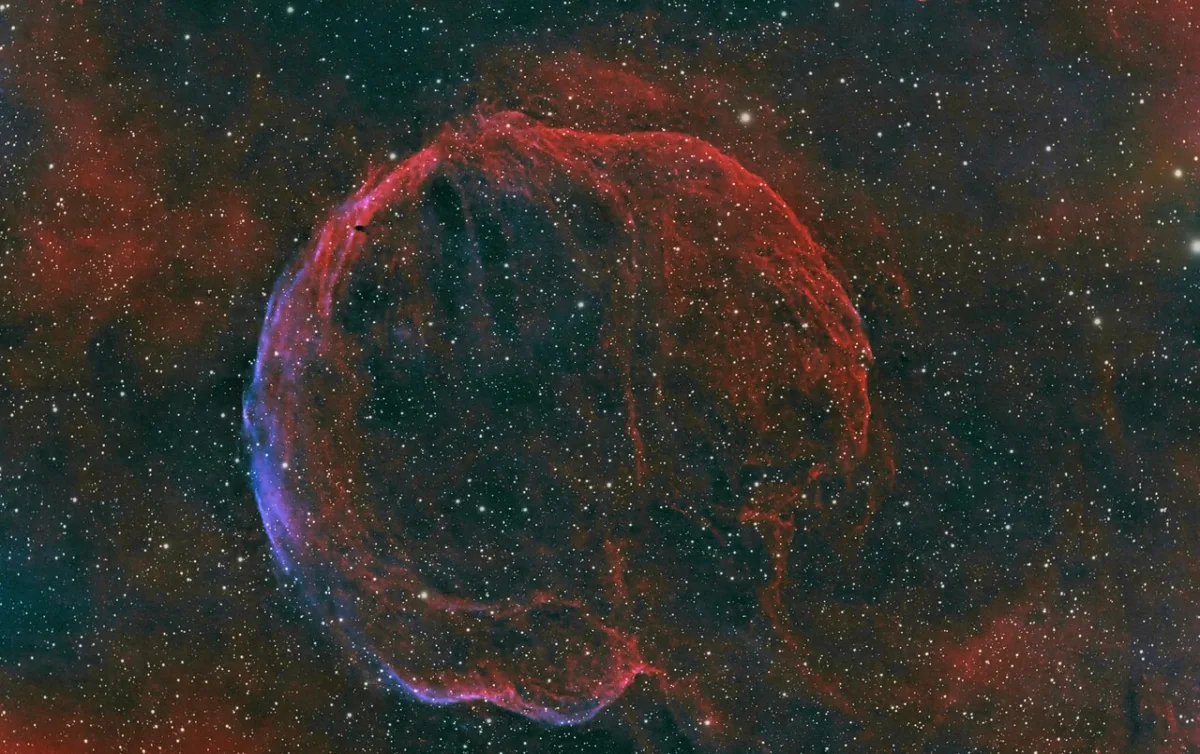
Medulla Nebula (CTB 1), image credit: Flickr Commons/Astrophoto Andy (CC0 1.0)
In 2010, observations with the Chandra X-ray Observatory revealed that the Medulla Nebula was rich in oxygen and neon, which is unusual for an evolved remnant. The derived elemental abundances indicated that the stellar progenitor had a mass of at least 13 – 15 solar masses.
In 2024, observations with the PUMA interferometer on the 2.1-m telescope at San Pedro Mártir National Astronomical Observatory led to a kinematic distance of 3.8 ± 0.3 kpc (12,394 ± 978 ly) and a linear diameter of 19 ± 3 pc (62 ± 10 ly) for the supernova remnant. A team of astronomers led by J. Reyes-Iturbide, Institute of Astronomy, National Autonomous University of Mexico, determined an expansion velocity of 286 km s-1 for the nebula and confirmed its classification as a mixed morphology supernova remnant. The team estimated a kinematic age of 26,000 ± 4,000 years for CTB 1.
Mixed-morphology supernova remnants show central thermal X-ray emission that is enclosed by a radio shell. The X-ray emission comes from the interstellar material swept up by the supernova. Other examples of this morphology include the Jellyfish Nebula (IC 443) in the constellation Gemini and W28 near the Trifid Nebula (Messier 20) in Sagittarius.
The often-cited mean measured age of 10,000 ± 2,000 years for CTB 1 was determined by C. J. Hailey & W. W. Craig in 1994; W. W. Craig et al. in 1997, and J. S. Lazendic & P. O. Slane in 2006. However, the age is uncertain. Reyes-Iturbide et al. were not the only astronomers to suggest that the remnant was older.
In 2023, Bruzewski et al. determined an age of 47.60 ± 0.80 kyr based on the proper motion of 35.3 ± 0.6 mas yr−1 for the Cannonball Pulsar. The refined proper motion measurement was based on several years of observations using very long baseline interferometry (VLBI).
The remnant of the progenitor star is catalogued as PSR J0002+6216. The pulsar was expelled by the supernova event at a high velocity. Original estimates of its velocity were over 1,000 km s-1, which led to the nickname Cannonball.
The Cannonball Pulsar is not to be mistaken for the Cosmic Cannonball (RX J0822−4300), a hypervelocity neutron star associated with the supernova remnant Puppis A in the constellation Puppis.
Cannonball Pulsar
The pulsar PSR J0002+6216 was discovered by the Einstein@Home project in data obtained with the Fermi Large Telescope (Fermi-LAT) in 2017. The pulsar was associated with the Medulla Nebula by Zyuzin et al. based on their proximity on the sky and similar distances in 2018.
In 2019, observations with the Very Large Array (VLA) supported this claim and led to the detection of a cometary-like tail 7 arcminutes across. A team of astronomers led by F. K. Schinzel of the National Radio Astronomy Observatory (NRAO), identified the tail as a bow-shock pulsar wind nebula. The pulsar itself lies at the apex of the tail, which points in the direction of the geometric centre of the Medulla Nebula. The pulsar and the supernova remnant are separated by 28 arcminutes on the sky.
PSR J0002+6216 has been nicknamed the Cannonball Pulsar because of its high velocity. Even though estimates of its velocity have been reduced since discovery, it is still one of the fastest moving pulsars detected to date. It has moved 53 light-years away from its original location since the supernova event that produced the Medulla Nebula.
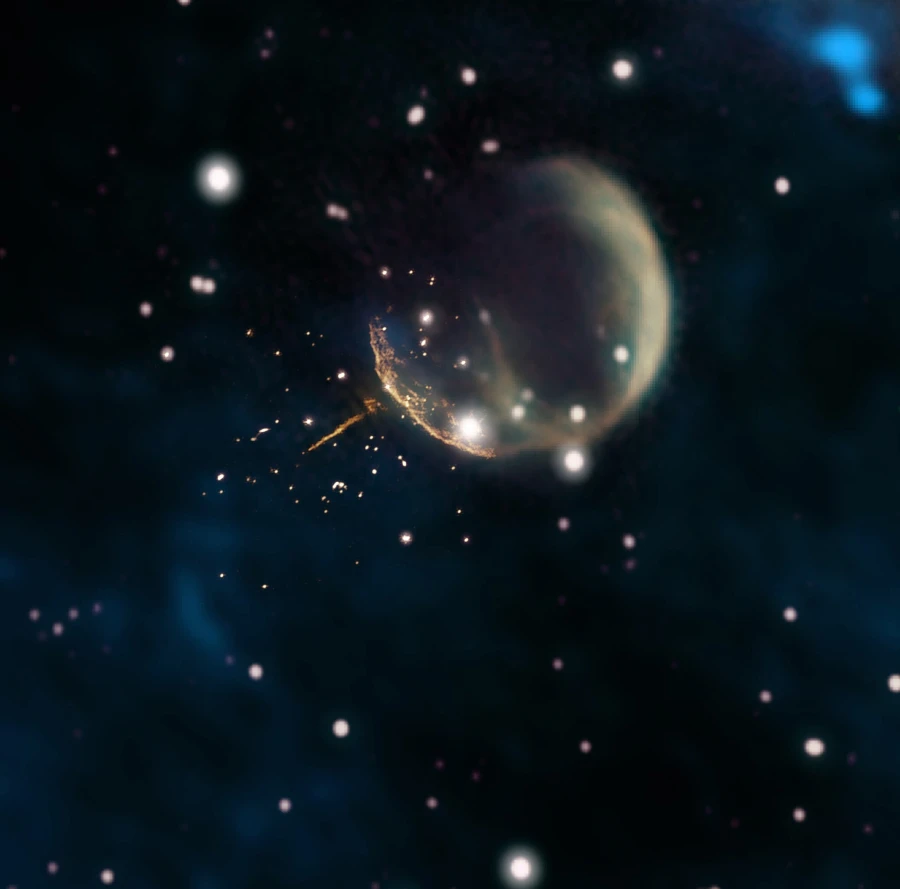
The CTB 1 supernova remnant resembles a ghostly bubble in this image, which combines new 1.5 gigahertz observations from the Very Large Array (VLA) radio telescope (orange, near center) with older observations from the Dominion Radio Astrophysical Observatory’s Canadian Galactic Plane Survey (1.42 gigahertz, magenta and yellow; 408 megahertz, green) and infrared data (blue). The VLA data clearly reveal the straight, glowing trail from pulsar J0002+6216 and the curved rim of the remnant’s shell. CTB 1 is about half a degree across, the apparent size of a full Moon. Credits: Composite by Jayanne English, University of Manitoba, using data from NRAO/F. Schinzel et al., DRAO/Canadian Galactic Plane Survey and NASA/IRAS (PD)
As it speeds through the interstellar medium, the Cannonball Pulsar is leaving a wake tail around 13 light-years long. It is associated with a bow-shock pulsar wind nebula. The pulsar currently lies at an estimated distance of 6,500 light-years from the Sun.
Pulsars are highly magnetized spinning stellar remnants – neutron stars – that emit beams of electromagnetic radiation out of their magnetic poles. The beams can only be detected when they are pointing towards Earth. The Cannonball Pulsar spins at a rate of 8.7 times per second.
Neutron stars like the Cannonball Pulsar form when massive stars reach the end of their life cycle and go out as supernovae. They are the gravitationally collapsed cores of the progenitor stars. They are denser than white dwarfs (remnants of low and intermediate-mass stars), but not as dense as black holes (remnants of exceptionally massive stars).
Neutron stars typically pack a mass of about 1.4 solar masses into a radius of only 10 kilometres. They are believed to be produced by stars with a mass of 10 – 25 solar masses. These stellar remnants form in core-collapse supernovae, which have a typical natal kick velocity of 200 – 500 km s-1.
In 2025, a team of astronomers led by Y. Wei, School of Physical Science and Technology, Xinjiang University, analysed data obtained with the Five-hundred-meter Aperture Spherical radio Telescope (FAST) and the Fermi Large Area Telescope and found that the Cannonball was not a hyper-velocity pulsar (exceeding 1,000 km s-1). The team determined a total proper motion of 39.05 ± 15.79 mas yr−1 for the pulsar.
Distance and size
The distance to the Medulla Nebula is uncertain. In the recent decades, astronomers have placed the nebula both in the Perseus Arm of the Milky Way and in the Local Arm. The more distant Perseus Arm is one of the Milky Way’s two major spiral arms, while the Local Arm (the Orion Arm) is a minor arm that contains our own solar system.
In 1986, M. Fich proposed a distance of 3.4 kiloparsecs (11,089 ly) for the nebula by comparing the velocity of the Perseus Arm centre with the distances of nearby H II regions.
In 1994, Hailey and Craig determined a distance of 3.1 ± 0.4 kpc (10,111 ± 1,305 ly).
In 2004, Yar-Uyaniker suggested that the remnant was located in the Local Arm, at an approximate distance of 1.6 kpc (5,219 ly) based on H I observations.
A 2020 study led by D. A. Leahy, Department of Physics and Astronomy, University of Calgary, found a radius of 15.3 ± 1.5 parsecs (50 ± 5 ly) based on a distance of 3.1 ± 0.3 kpc (10,111 ± 979 ly) and an angular size of 17 by 17 arcminutes. The astronomers derived an age of 16,700 years (+1,400, -1,300) for the remnant and a mass of 5 solar masses for the ejected material.
In 2025, a team led by Xiaohan Chen, CAS Key Laboratory of Optical Astronomy, National Astronomical Observatories, China, reported a distance of 3.383 ± 0.006 kpc (11,034 ± 20 ly) for the nebula based on an apparent diameter of 34 arcminutes. The researchers used the extinction-distance method. They obtained another extinction jump at 0.412 kpc (1,344 ly), which likely arises from a foreground cloud or the Local Arm.
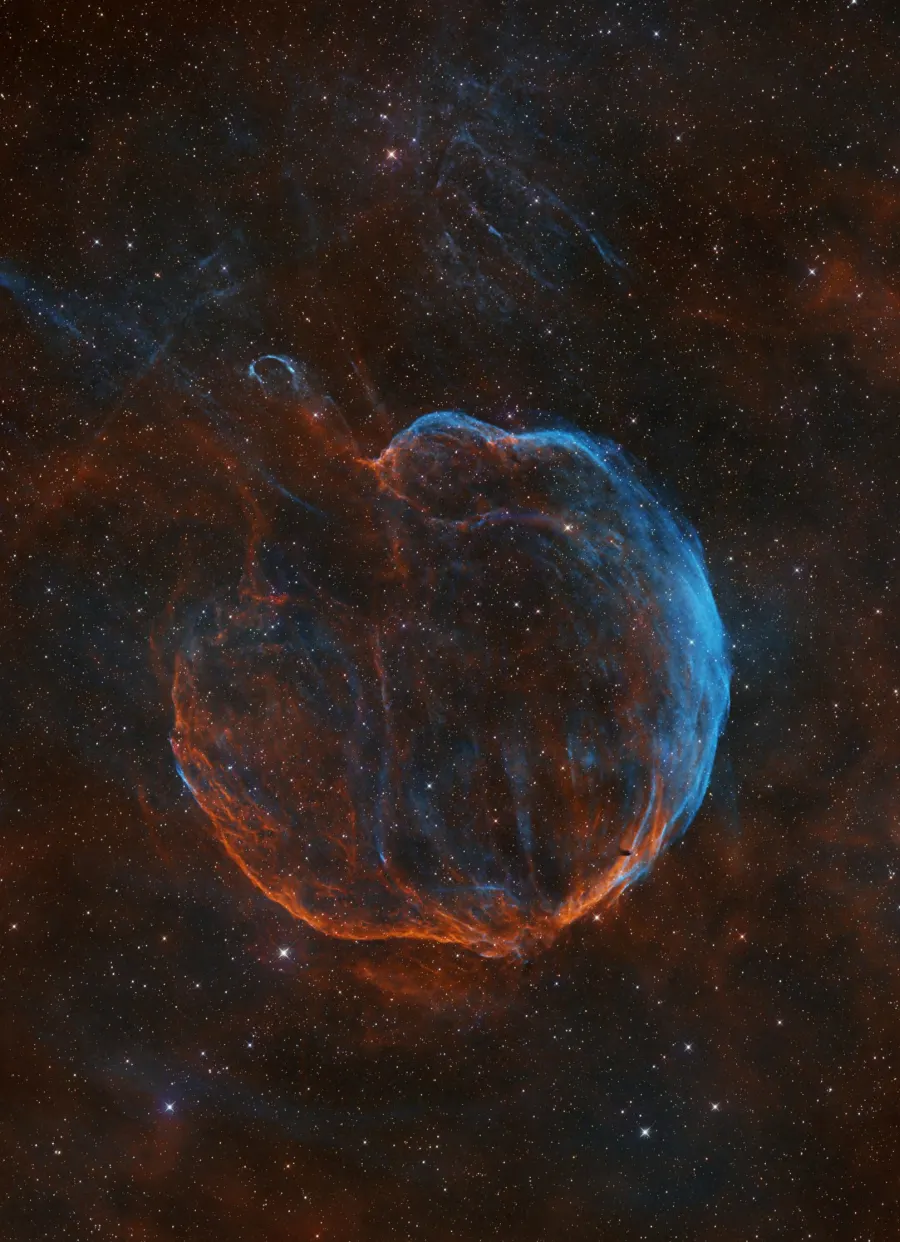
CTB 1, image credit: Manuel Peitsch (CC BY 4.0)
Facts
The supernova remnant CTB 1 was first noted by the American astronomer George Ogden Abell on a photographic plate obtained during the National Geographic Society – Palomar Observatory Sky Survey (POSS) in 1955. Abell listed the object as number 72 in his 1955 paper, believing it to be an old planetary nebula. In 1966, Abell listed the nebula as number 85 (Abell 85) in the second publication of his survey of planetary nebulae, noting that it may in fact be a supernova remnant.
The Medulla Nebula was discovered as a radio source by R. W. Wilson and J. G. Bolton, California Institute of Technology Radio Observatory, in a survey of galactic radiation at a frequency of 960 MHz in 1959-1960. CTB 1 was one of the 110 discrete radio sources detected by the Caltech astronomers. They listed it as object number 1 in their 1960 study. The designation CTB stands for Caltech Observation List B.
American astronomer Beverly T. Lynds included the supernova remnant as LBN 576 (LBN 116.81+00.03) in her Lynds’ Catalogue of Bright Nebulae of 1965. She listed the object as an H II region.
The Medulla Nebula was confirmed to be a supernova remnant by A. Poveda, National Astronomical Observatory, Mexico (UNAM), and L. Woltjer, Department of Astronomy, Columbia University, in 1968. The astronomers measured an angular diameter of 120 arcminutes for CTB-1, corresponding to a physical size of 117 light years (36 parsecs) at a distance of 6,523 light-years (2,000 pc).
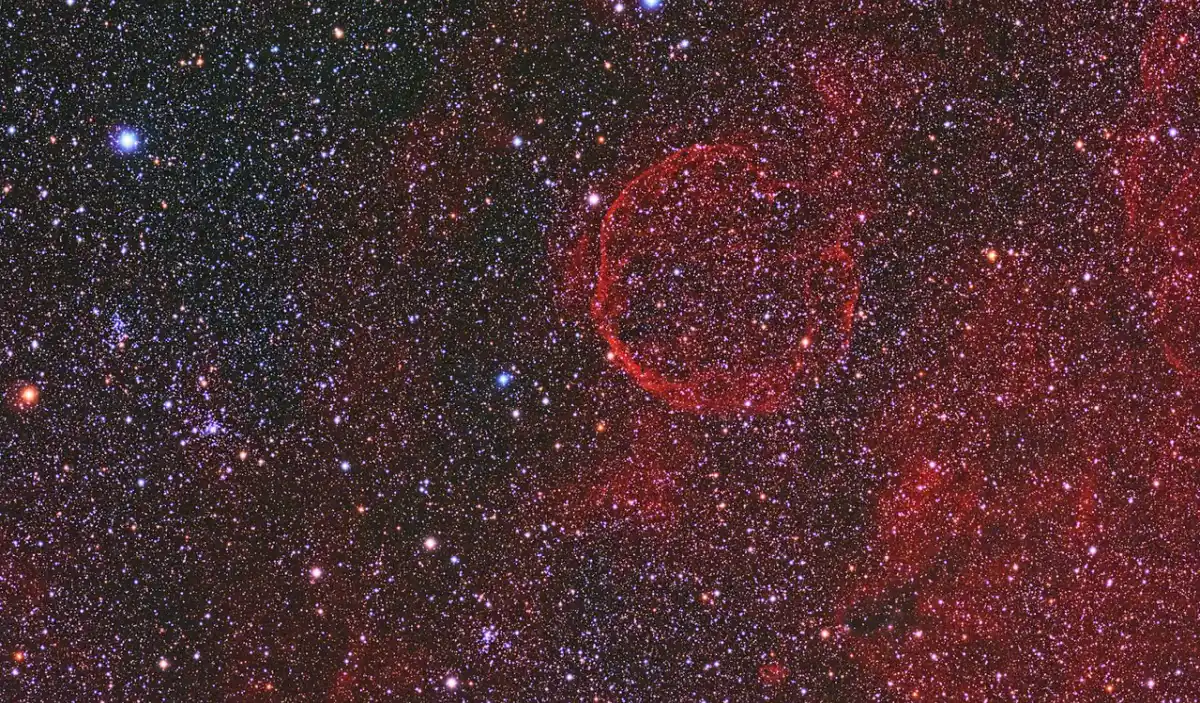
Supernova remnant CTB 1 in Cassiopeia, image credit: Kees Scherer (CC0 1.0)
Location
The Medulla Nebula is located in the northern constellation of Cassiopeia (the Queen). It appears above the right side of Cassiopeia’s W and forms a triangle with the bright Caph (Beta Cassiopeiae) and Kappa Cassiopeiae.
The Medulla Nebula is about as large as the full Moon but has low surface brightness and is best seen photographically. It cannot be observed even in larger amateur telescopes with filters because of its faintness and large size.
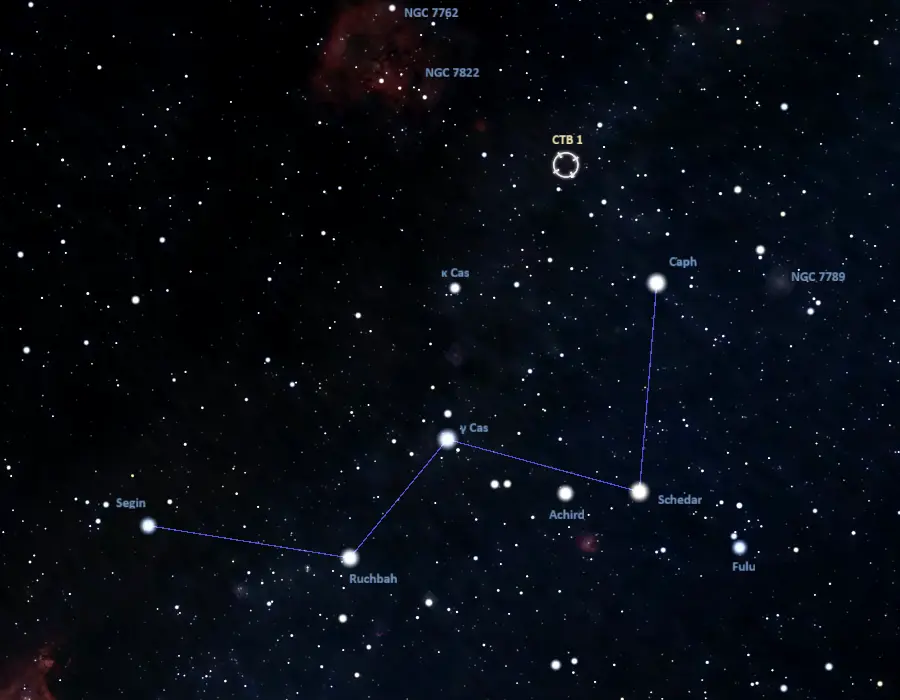
Location of the Medulla Nebula (CTB 1), image: Stellarium
Medulla Nebula – CTB 1
| Constellation | Cassiopeia |
| Object type | Supernova remnant (SNR) |
| Right ascension | 23h 59m 13s |
| Declination | 62° 26′ 12″ |
| Apparent size | 34.0′ x 34.0′ |
| Distance | 14,000 ± 650 light-years (4,300 ± 200 parsecs), or 10,111 ± 978 light-years (3.1 ± 0.3 kpc), or 11,045 ± 20 light-years (3.383 ± 0.006 kpc), or 12,394 ± 978 light-years (3.8 ± 0.3 kpc) |
| Names and designations | Medulla Nebula, Garlic Nebula, Garlic Bulb Nebula, Popped Balloon Nebula, CTB 1, SNR G116.9+00.1, SNR G116.9+00.2, SNR G117.3+00.1, LBN 576, LBN 116.81+00.03, AJG 110, DA 615, PN A55 72, PN A66 85, Abell 85, VRO 62.23.01 |